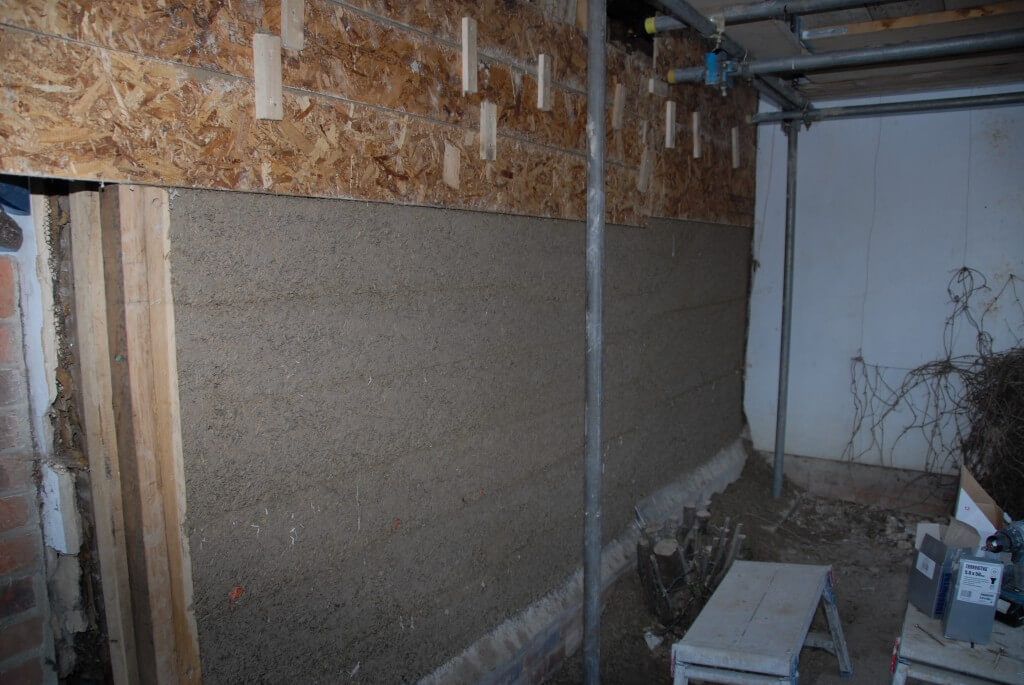Hempcrete buildings – thermal performance and costs
What can I expect from hempcrete in terms of its thermal performance?
The thermal properties of hempcrete are extraordinary. It provides insulation because of pockets of air trapped within the material; both in the spaces between particles of hemp shiv, and in microscopic pores in the hemp shiv itself. Compared to synthetic insulation materials, hempcrete is a less-effective insulator, For example 240mm thickness of hempcrete meets current UK building regulations for insulation (compared to around 80 mm of polyurethane insulation board). However because hempcrete is cheaper than synthetic insulation materials, and is used to form a monolithic wall, the usual thickness of hempcrete applied in a new building is 300-400mm for a wall.
The typical thermal conductivity of hempcrete is typically 0.06 to 0.07 W/mK. U-values for hempcrete vary depending on the thickness, the type of binder used, the exact specification, application techniques and the skill of the contractor, however a typical u-value (for a 350mm thick hempcrete wall) is 0.17 W/m2K.
Hempcrete also provides thermal mass, as well as insulation, due to density of the lime binder once it has set. This means that hempcrete is able to store heat within the fabric of the material itself (like a giant storage heater). In this respect it is unlike lightweight insulations which only store heat within the air trapped inside the material. The ability of hempcrete to store heat in this way as well as insulating has two important advantages.
Firstly, it allows for natural ventilation of the building. Whereas modern highly insulated buildings rely on airtightness alone to trap the air within the lightweight insulation layer (leading to the use of closed windows – to preserve the heat – with trickle vents and mechanical heat recovery systems to ensure indoor air quality), hempcrete stores heat (from the sun, or from internal heating) in the thermal mass of its walls, to be released slowly as the building cools down. This means that in a hempcrete home you can open the window if it gets a bit stuffy; safe in the knowledge that all your expensive heat is not going to flow straight out and be lost.
Secondly the slow speed at which a typical hempcrete wall stores and releases heat has the effect of “buffering” natural changes in internal and external temperatures, e.g. night and day temperature fluctuations, so that with very little heating or cooling a constant internal temperature is maintained. Hempcrete keeps your home cool in the summer and warm in the winter, with a dramatic reduction in fuel bills.
Hempcrete is unique in this mixture of insulation and thermal mass. It can be thought of (in terms of natural materials) as halfway between straw bale (which has loads of insulation, but very little thermal mass) and cob (which has loads of thermal mass and very little insulation). The combination of the two gives hempcrete an extraordinary thermal performance which works dynamically to maintain comfortable indoor temperatures with very little need for mechanical heating, cooling or ventilation. During in-situ testing, hempcrete consistently out-performs expectations based on laboratory tests and computer modelling.
How much does building with hempcrete cost?
Building with hempcrete should cost no more than building with conventional materials, however it will not be significantly cheaper either.
As with any material, costs vary depending on the complexity of the design, the exact specification, and a number of other factors. Broadly speaking though, the cost of building with hempcrete should be around the same as building with a conventional “brick and block cavity” construction including a high-spec insulation in the cavity. In certain situations hempcrete offers a distinct advantage and can allow considerable savings in the build cost. For example when the ground is not suitable for a strip foundation, a hempcrete building (due to hempcrete’s lower density) can be built on a cheaper raft foundation, avoiding the extra cost (both financial and environmental) of a massive concrete slab.
Remember that this comparison is looking only at the construction costs. The extra thermal performance which hempcrete provides brings significant extra savings over the lifetime of the building, as well as improved health of the buildings occupants.
 UK Hempcrete
UK Hempcrete
